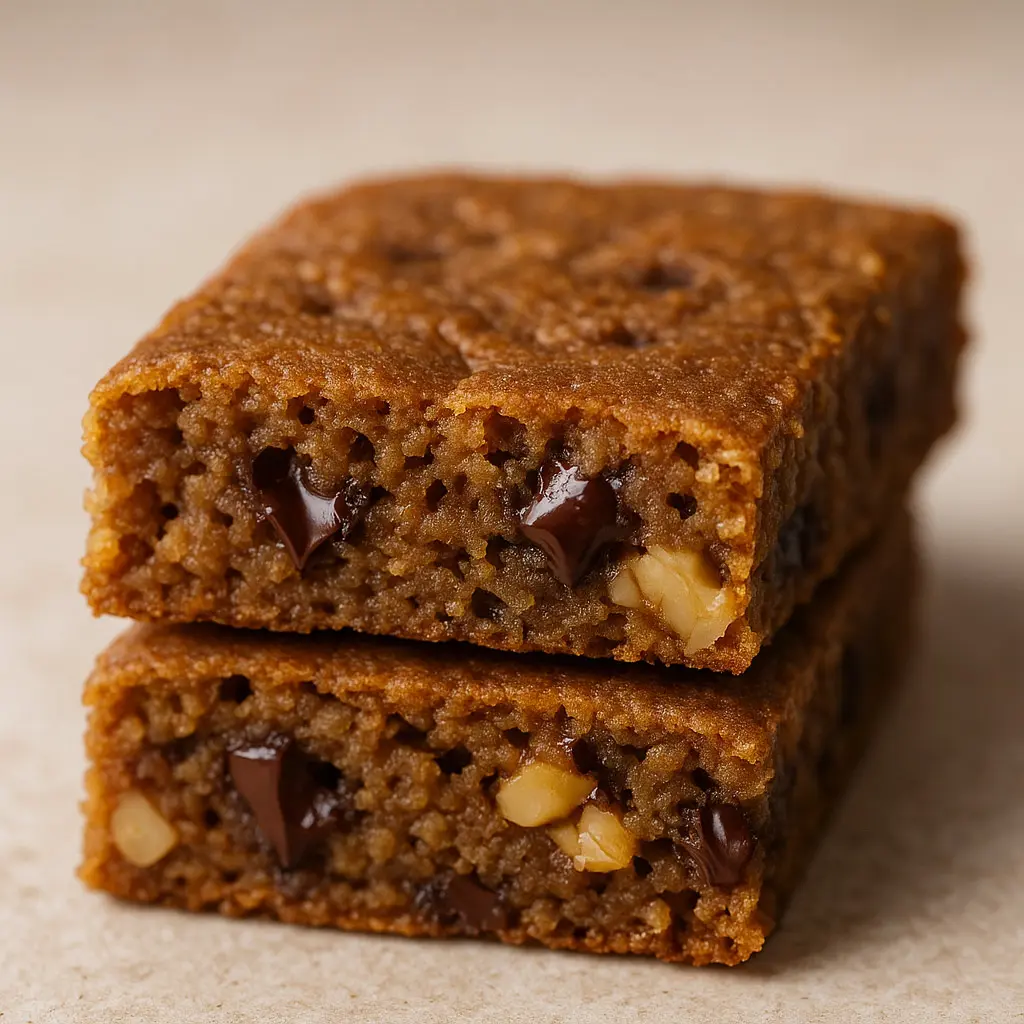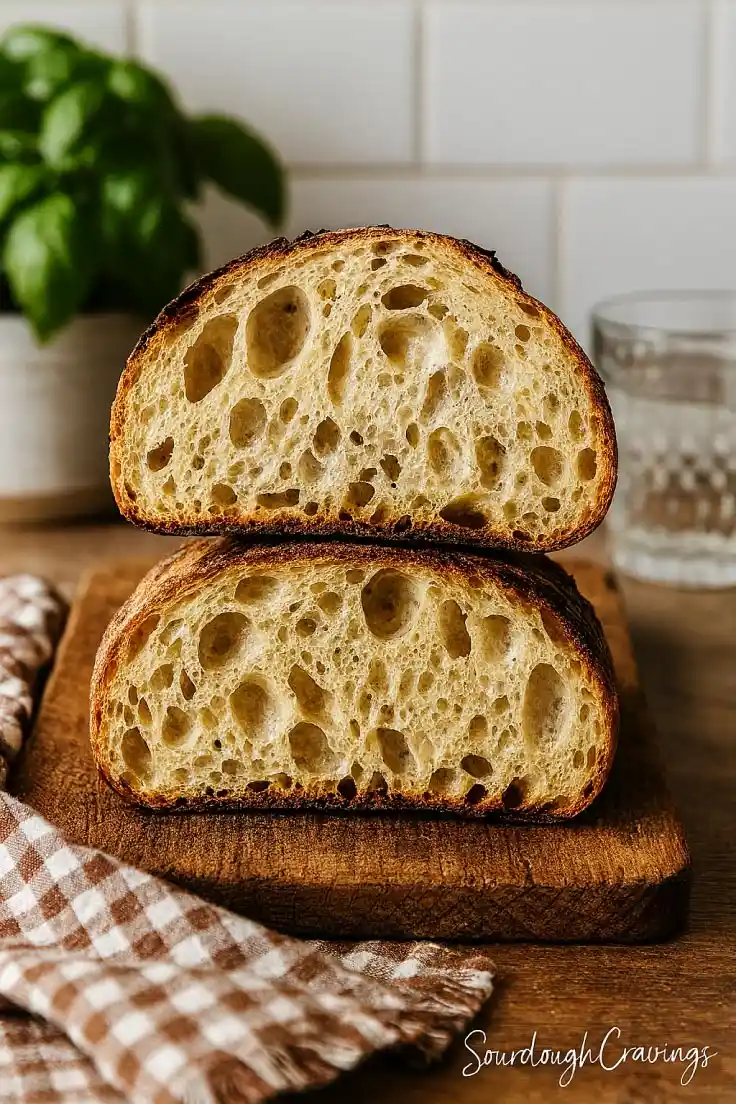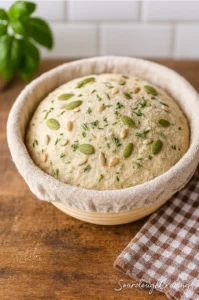Cranberry Orange Sourdough Bread: A Sweet & Zesty Favorite
Cranberry orange sourdough bread is a festive, naturally leavened loaf packed with tart cranberries, bright citrus zest, and just the right sourdough tang. It’s the perfect sweet-meets-savory bake for brunch, gifting, or cozy mornings. (For more mix-in ideas, check out my Best Sourdough Inclusions guide.)

This loaf came to life one snowy December afternoon, when I tossed a handful of cranberries and fresh orange zest into my usual dough on a whim. Since then, it’s become a seasonal favorite in our house—zippy, vibrant, and just nostalgic enough to feel special every time it hits the table.
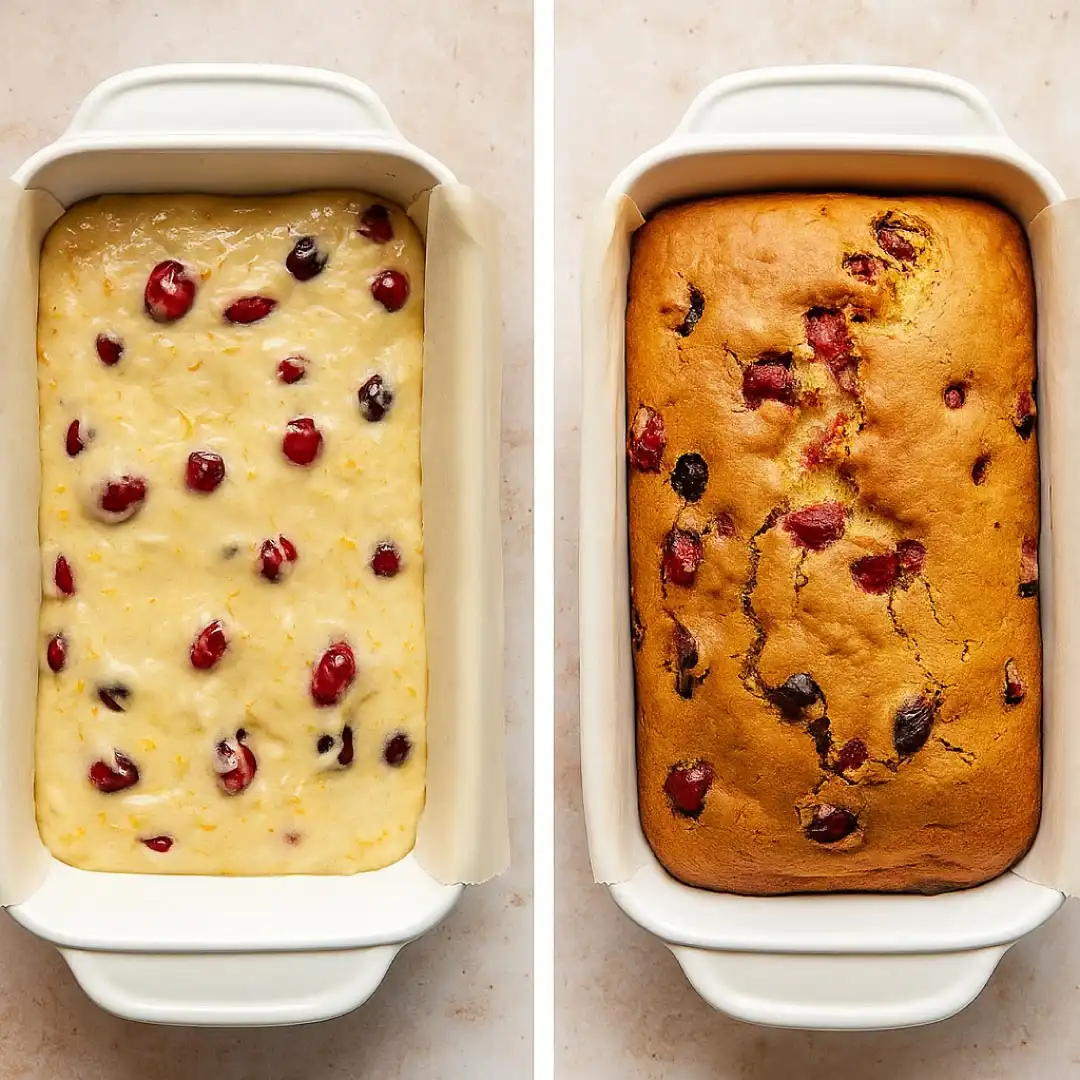
Cranberry Orange Sourdough Bread
Ingredients
Method
- Feed the Starter : Feed your starter and let it reach peak activity.
- Mix Ingredients Mix starter, water, orange juice, and flour into a shaggy dough. Rest for 45 minutes.
- Add Salt and Zest : Add salt and orange zest. Mix well by hand.
- Bulk Fermentation : Begin bulk fermentation. Do stretch and folds every 30 minutes for the first 2 hours.
- Add Cranberries : After the second fold, add cranberries. Fold gently.
- Let It Rise : Let rise for 4–6 hours total until doubled in size.
- Pre-shape and Final Shape : Pre-shape the dough, rest for 20 minutes, then final shape into a banneton.
- Cold Proof : Place in the fridge to cold proof for 12–18 hours.
- Bake : Preheat Dutch oven to 475°F. Score and bake: 20 min covered, then 25 min uncovered at 450°F.
- Cool : Cool fully before slicing and serving.
Nutrition
Notes
Loved this recipe?
Leave a rating & comment. how it was!In this post, I’ll walk you through how to bake cranberry orange sourdough bread from scratch, including my go-to tips, what to avoid, and how to get that bakery-style crust right in your home oven. We’ll also break down what orange juice actually does to dough (spoiler: it’s not just flavor) and whether fresh cranberries work better than dried. Let’s get that starter ready—it’s baking time!
Table of Contents
Cranberry Orange Sourdough Bread Ingredients You’ll Need
Making cranberry orange sourdough bread is all about starting strong with simple, quality ingredients. Each component plays a specific role—so even though the list is short, every choice counts. One of the things I love most about sourdough baking is how the base stays consistent, but the flavor possibilities are wide open depending on what you fold in. And when you add tart cranberries and bright orange zest? That’s when things really get interesting.
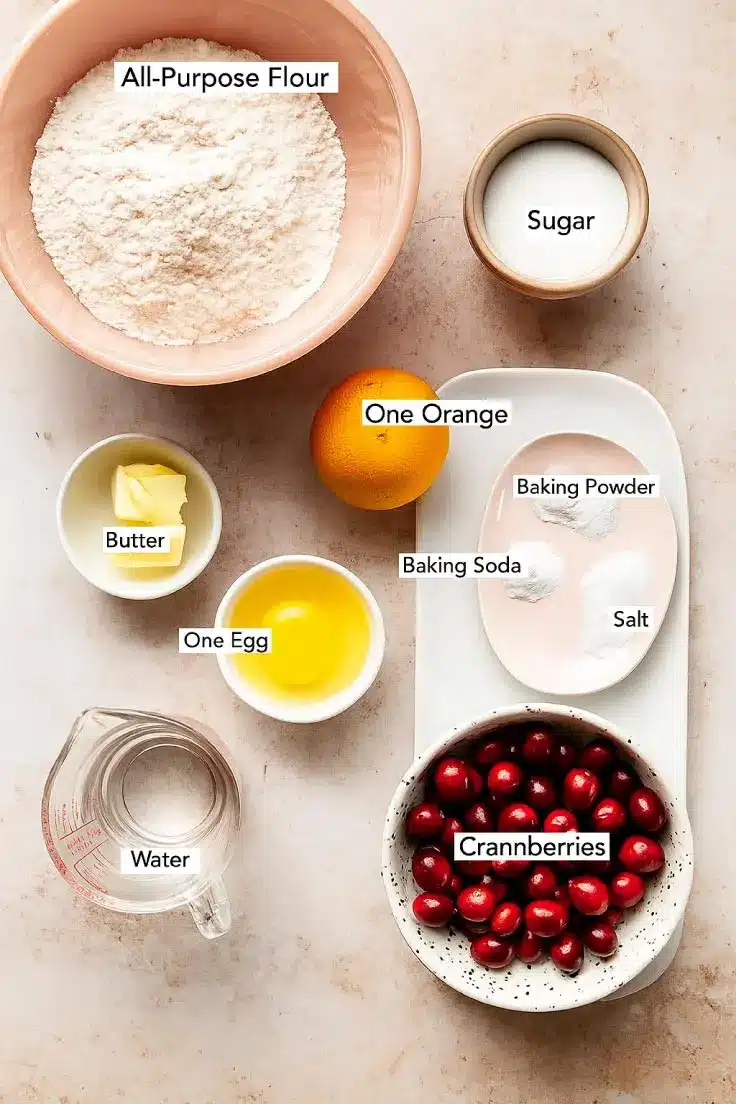
If you’ve been experimenting with sweet sourdough add-ins like I have (especially after testing my Brown Sugar Cinnamon Sourdough Bread), you know that balance is everything. The same rule applies here.
Here’s what you’ll need:
Basic Dough:
- 100g active sourdough starter (fed and bubbly)
- 350g bread flour (or a blend of bread and all-purpose)
- 250g water
- 7g salt
Flavor Boosters:
- 100g dried cranberries (or 120g fresh)
- Zest of 1–2 oranges
- 30g freshly squeezed orange juice (reduce water slightly to balance)
Fresh vs. Dried Cranberries in Sourdough
When making cranberry orange sourdough bread, one of the biggest questions I get is: “Can I use fresh cranberries?” And yes—you absolutely can. I actually love the little pops of tartness they bring. That said, dried cranberries are more predictable, easier to fold in, and lend a bit of chew and sweetness to every bite.
If you’re using fresh cranberries, I recommend halving or quartering them so they distribute evenly and don’t burst too much during baking. Just keep in mind: fresh fruit can increase hydration, so reduce your water slightly to compensate.
If you’re curious about other unexpected add-ins that actually work in sourdough (savory or sweet!), definitely check out Best Sourdough Inclusions: Savory & Sweet Add-Ins That Actually Work—it’s loaded with flavor pairings and texture tips.
Orange Zest, Juice, and the Citrus Twist Factor
Orange zest is where the magic happens in cranberry orange sourdough bread. It adds that aromatic brightness you can smell even before slicing into the loaf. I always use a microplane to get fine zest without any bitter pith—just the good stuff.
As for orange juice? A splash adds subtle sweetness and acidity, but you don’t want to overdo it. Too much juice can weaken gluten and slow fermentation, so think of it as an accent, not a replacement for water. (More on the science behind this in the next section!)
Cranberry Orange Sourdough Bread Ingredients You’ll Need
Cranberry orange sourdough bread is one of those bakes that proves just how magical sourdough can be. It starts with a classic base—flour, water, salt, and starter—and transforms into a sweet, tangy showstopper with just a few flavorful twists. The key to baking truly memorable cranberry orange sourdough bread is choosing ingredients that complement, not compete. It’s about letting that natural citrus brightness and cranberry zing shine through the chewy sourdough crumb.
I’ve baked this cranberry orange sourdough bread more times than I can count, especially during the cooler months when citrus is at its best. Over time, I’ve learned how even the smallest adjustment—like switching from dried to fresh cranberries or balancing the orange juice just right—can dramatically change the loaf. If you’ve ever tried flavor-forward recipes like my Brown Sugar Cinnamon Sourdough Bread, you already know how intentional ingredients shape a sourdough loaf from the inside out.
Here’s what you need to make your own unforgettable cranberry orange sourdough bread.
Basic Dough
- 100g active sourdough starter (bubbly and ready)
- 350g bread flour
- 250g filtered water
- 7g fine sea salt
This is your foundational dough. For cranberry orange sourdough bread, I recommend bread flour for strength and structure, especially since the mix-ins add moisture and texture.
- 100g dried cranberries (or 120g fresh, halved)
- Zest of 2 medium oranges
- 30g fresh orange juice (reduce water to 220g if using)
These are what transform this from a basic loaf into signature cranberry orange sourdough bread. Orange zest gives you that warm citrus aroma, while juice subtly sweetens and balances the cranberries’ natural tartness.
Fresh vs. Dried Cranberries in Cranberry Orange Sourdough Bread
You can absolutely use either fresh or dried cranberries in your cranberry orange sourdough bread. I’ve tested both, and they each have their charm. Fresh cranberries make the loaf look rustic and festive, with juicy pockets that pop as you bite in. But they do add extra hydration, so be sure to slightly reduce your water if going fresh.
Dried cranberries give more consistency, chewiness, and a gentle sweetness that works beautifully with the tangy dough. Just avoid varieties with too much added sugar or oil. (Pro tip: soak dried ones in warm orange juice for 15 minutes before folding in—trust me.)
If you’re curious about other fun additions that really work in sourdough, you’ll love my breakdown of Best Sourdough Inclusions: Savory & Sweet Add-Ins That Actually Work. It’s where I first explored what flavors play nicely with bold sourdough notes.
Why Orange Juice Matters in Cranberry Orange Sourdough Bread
Using orange juice in cranberry orange sourdough bread might sound like a flavor thing—and it is—but there’s more to it. Juice adds mild acidity, which can slow down fermentation slightly but also tenderizes the crumb and deepens the citrus profile. Just don’t overdo it. A little juice goes a long way, and too much can disrupt gluten development.
The result? A loaf that smells amazing, tastes like winter sunshine, and looks like something straight from your favorite artisan bakery.
How to Make Cranberry Orange Sourdough Bread at Home
The beauty of cranberry orange sourdough bread is that it’s as beautiful to make as it is to eat. From the moment you zest those oranges to the final crackle of the crust coming out of the oven—it’s the kind of bake that reminds you why you fell in love with sourdough in the first place.
This recipe follows a typical sourdough rhythm, just with a fruity twist. And don’t worry—it’s flexible enough for weeknight prep or weekend baking. Once you’ve mastered this cranberry orange sourdough bread, you’ll find the same process works wonders with other inclusions too (like the bold and savory notes in my Jalapeño Cheddar Sourdough, which takes spice and sour to a whole new level).

Step 1: Feed Your Starter
Start with an active, bubbly starter. If your starter has been in the fridge, give it two feeds before baking to ensure it’s lively enough to raise your cranberry orange sourdough bread. I like to feed mine the night before and again in the morning, aiming for a 1:1:1 ratio of starter, flour, and water.
Let it rise until it’s at its peak—usually 4 to 6 hours, depending on your kitchen’s temperature.
Step 2: Mix the Dough
In a large bowl, mix:
- 100g active starter
- 250g water (or 220g if using orange juice)
- 30g fresh orange juice
- 350g bread flour
Stir until you form a shaggy dough. Cover and let rest (autolyse) for 45 minutes.
After resting, add:
- Zest of 2 oranges
- 7g salt
Use your hands to squeeze and fold the dough until the salt and zest are fully incorporated. It’ll smell amazing at this point—like a bakery collided with a citrus grove.
Step 3: Bulk Fermentation and Stretch & Folds
Let your cranberry orange sourdough bread dough rise at room temperature for 4–6 hours, performing stretch and folds every 30 minutes during the first 2 hours. This helps build structure and distribute those lovely inclusions later.
After the second fold, gently fold in:
- 100g dried cranberries or 120g halved fresh cranberries
Try to keep them evenly spaced while being gentle not to tear the dough. It’ll look like a festive mosaic—and taste even better.
Step 4: Shape and Cold Proof
After bulk fermentation, turn the dough out onto a floured surface. Pre-shape into a round and let rest for 20 minutes. Then, do your final shape and place into a banneton (or floured towel-lined bowl).
Cover and refrigerate for 12–18 hours. This cold proof deepens the flavor and gives your cranberry orange sourdough bread that signature sourdough tang.

Step 5: Score and Bake
Preheat your Dutch oven at 475°F for 30–45 minutes. Carefully place your dough in the pot, score with a lame or sharp blade (a curved score works well for dramatic oven spring), and cover.
Bake:
- 20 minutes with lid on
- 20–25 minutes uncovered at 450°F
Your kitchen will smell like citrus, toasted bread, and holiday magic.
Cranberry Orange Sourdough Bread Flavor Profile Explained
If you’ve ever wondered why cranberry orange sourdough bread just works, you’re not alone. I used to question if I was being influenced by cozy holiday vibes or if this combo really had that flavor chemistry. Turns out—it’s both. The beauty of this loaf is in the way opposites play together—tangy versus sweet, soft crumb against crusty edges, and that lively citrus note layered over earthy sourdough.
Baking cranberry orange sourdough bread is like building a layered song: the tang of the fermented dough sets the stage, the cranberries bring those bright high notes, and the orange zest fills in with citrusy warmth. It’s a loaf that doesn’t just taste good—it feels like a little celebration in every bite.
Do Cranberry and Orange Go Together in Sourdough?
Short answer? Absolutely. The sharpness of cranberries pairs beautifully with the sourdough’s naturally acidic flavor. It’s the kind of pairing that creates something richer than either flavor could offer on its own. In cranberry orange sourdough bread, the orange zest acts like a bridge—tying together the sour and tart with a touch of sweetness.
There’s actual science behind these complementary flavors—King Arthur Baking explains how acidity and sugar balance each other in sourdough, helping complex flavors shine through. That’s why this citrusy combo feels so bright and vibrant against the naturally tangy dough.
If you love bold flavor contrasts like this, I’d also recommend checking out my Jalapeño Cheddar Sourdough. It uses the same method, but with savory heat and cheese instead of citrus and fruit. Both are proof that sourdough is the ultimate canvas for creativity.
What Does Orange Juice Do to Bread Dough?
Here’s where it gets fun. When you add orange juice to your cranberry orange sourdough bread, you’re doing more than flavoring the dough. Orange juice brings more than flavor—it adds gentle acidity, natural sugars, and extra hydration, all of which subtly shift the fermentation process.
The acidity from the juice slightly lowers the dough’s pH, which can slow fermentation just enough to develop deeper flavors. Those natural sugars from the juice also promote browning in the oven, helping the crust develop a warm, golden finish that’s pure eye candy. You’ll also notice your loaf smells incredible during baking—like marmalade meets fresh bread.
The key is balance. Too much juice and your gluten network might suffer. That’s why I recommend replacing only a small portion of your water with juice—just enough to amplify the citrus without compromising structure. In the end, your cranberry orange sourdough bread will have a tender crumb, a crackly crust, and that unmistakable citrusy depth.
Flavor Tip: Let It Rest Before Slicing
Yes, it’s tempting. Yes, I’ve done it anyway. But letting your cranberry orange sourdough bread rest for at least an hour (two if you can manage!) after baking allows the flavors to settle and moisture to redistribute. You’ll get cleaner slices and better flavor.
If you’re planning to serve it the next day, store it in a paper bag or wrap in a clean kitchen towel. I sometimes toast slices and top them with cream cheese, a drizzle of honey, or—hear me out—a swipe of cinnamon butter. Flavor heaven.
Cranberry Orange Sourdough Bread Tips for Success
Baking cranberry orange sourdough bread is a joyful adventure, but I’ll be real—it can go sideways fast if your timing or ingredients are even a little off. I’ve had loaves spread like pancakes, rise too much, or turn out way too tart. But over time, and many sticky counters later, I’ve picked up a handful of tricks that make all the difference.
Whether you’re brand new to sourdough or looking to tweak your citrus game, these tips will help you get the most out of every bake. Plus, if you love sweet-and-savory combos like this one, these same tips will absolutely come in handy for bolder loaves too—like my Jalapeño Cheddar Sourdough, where moisture balance is just as important.
The Biggest Mistake with Your Sourdough Starter
Let’s start with the foundation: your starter. The single biggest mistake I see with cranberry orange sourdough bread (or any sourdough recipe, honestly) is using an underfed or sluggish starter. If your starter isn’t at peak activity—meaning it doubles within 4–6 hours of feeding and smells pleasantly tangy—you’re not setting yourself up for success.
Using a weak starter can lead to:
- Underproofed loaves
- Dense or gummy crumb
- Your loaf might not rise much in the oven—especially when you’re working with heavier mix-ins like cranberries that weigh the dough down if not handled correctly.
To avoid this, feed your starter consistently for a day or two leading up to your bake. And if you’re unsure it’s ready, try the float test: drop a small spoonful into water. If it floats, it’s ready to use. If it sinks, give it more time.
Adjust Hydration When Using Fresh Cranberries
One sneaky challenge with cranberry orange sourdough bread is that fresh cranberries release moisture during baking. This can mess with your dough’s structure if you don’t account for it. I recommend:
- If you’re using fresh cranberries, reduce your water by about 20 to 30 grams to avoid making the dough too wet.
- For best results, add your cranberries during the second or third round of folding—this helps keep the dough’s strength intact while spreading the fruit evenly.
That adjustment helps your dough stay structured during shaping while still baking up light and tender inside. If your dough starts feeling overly slack or wet, add an extra light fold and give it a bit more rest between rounds.
Don’t Overdo the Orange Juice
Orange juice adds amazing depth to cranberry orange sourdough bread, but it should complement—not replace—your hydration. Too much juice can slow fermentation and weaken your gluten development. I’ve found that swapping in 25–30g juice for an equal part of water gives you just the right amount of citrus flavor without throwing off the dough.
Skip the Add-Ins Until After the Gluten Develops
It’s tempting to toss in everything from the beginning, but in enriched sourdoughs like this one, timing matters. I like to fold in the cranberries and zest once the dough has a bit of strength—usually after the first or second stretch-and-fold. This lets your gluten network form without interference, and you’ll get better distribution without tearing the dough.
Looking for more unique flavors to try in your sourdough? Don’t miss my post on Best Sourdough Inclusions: Savory & Sweet Add-Ins That Actually Work. It’s where I share all the mix-ins that actually pair well with sourdough’s natural tang—trust me, you’ll want to bookmark it.
Use a Dutch Oven and Get Steamy
To get that beautiful, shiny crust on your cranberry orange sourdough bread, bake it in a preheated Dutch oven. The sealed environment traps steam, which helps the crust expand before setting. That’s how you get that bakery-style crackle and rich, golden color without fancy tools.
If you don’t have a Dutch oven, place a metal pan on the lower oven rack and pour in hot water when you load the bread. Steam in those first 15 minutes is key.
Cranberry Orange Sourdough Bread FAQs
If you’re baking cranberry orange sourdough bread for the first time—or even the tenth—questions are bound to pop up. Trust me, I’ve been there, cranberries rolling off the counter and all. These are the top questions I hear from readers and friends who want to bake a loaf that looks (and tastes) like it came from a cozy artisan bakery.
Can I Put Fresh Cranberries in Sourdough?
Absolutely! You can use fresh cranberries in cranberry orange sourdough bread to give it a bold, tart punch and a more rustic texture. I love using fresh berries in the fall and winter, especially when they’re in season. That said, fresh cranberries carry more moisture than dried ones, which means they’ll release water into your dough as it ferments and bakes.
To make your cranberry orange sourdough bread turn out just right, reduce the total water in your dough by about 20–30 grams. I also recommend halving or quartering the cranberries so they distribute more evenly without bursting too much during baking.
Do Cranberry and Orange Go Together?
Yes—and not just in muffins or holiday punch. Cranberry and orange are a powerhouse duo in cranberry orange sourdough bread. The tartness of cranberries pairs beautifully with the sweet, fragrant brightness of orange zest and juice. When you mix these flavors into sourdough, the result is layered and balanced: tangy, sweet, and aromatic.
That contrast is exactly what makes cranberry orange sourdough bread so satisfying. The citrus lifts the sourdough’s natural tang, while the cranberries add a pop of flavor in every slice. Whether you’re serving it for brunch or toasting a slice with honey butter, this flavor pairing never fails.
What Does Orange Juice Do to Bread Dough?
In cranberry orange sourdough bread, orange juice brings a double win—flavor and function. It adds gentle acidity and natural sugars, both of which impact how your dough behaves. The acidity can slightly slow fermentation, which actually gives your loaf more depth of flavor. And the sugars? They help create a rich, golden crust when the loaf hits the heat.
I like to swap in about 25 to 30 grams of fresh orange juice for part of the water. That’s just enough to enhance the citrus notes without making the dough too soft. Used this way, orange juice helps your cranberry orange sourdough bread bake up with a tender crumb, a flavorful crust, and a subtle sweet aroma that fills the kitchen.
What Is the Biggest Mistake You Can Make with Your Sourdough Starter?
Hands down, the biggest mistake when baking cranberry orange sourdough bread is using a starter that isn’t fully active. If your starter hasn’t doubled, looks flat, or smells off, your dough won’t rise properly—and that gorgeous loaf you imagined will turn out flat or gummy.
Before using it in cranberry orange sourdough bread, make sure your starter:
Doubles within 4–6 hours of feeding
Is full of visible bubbles
Smells mildly tangy (not boozy or acidic)
It’s especially important with enriched sourdoughs like cranberry orange sourdough bread, where inclusions like fruit and juice can weigh the dough down. A strong, active starter gives you the oven spring and crumb you’re aiming for.
Want more sourdough inspiration? Don’t miss my go-to guide for Best Sourdough Inclusions: Savory & Sweet Add-Ins That Actually Work. It’s full of ideas that pair well with sourdough’s natural tang—perfect if you love baking with flavor in mind.
Serving & Storing Cranberry Orange Sourdough Bread
Once you’ve pulled your cranberry orange sourdough bread from the oven, the hardest part is waiting for it to cool. That citrusy aroma? It’s enough to test anyone’s willpower. Whether you’re slicing into it warm or stashing it for the week, this loaf is one of those bakes that’s just as good on day three as it is fresh out of the oven—if you store it right.
How to Serve Cranberry Orange Sourdough Bread
This cranberry orange sourdough bread is naturally sweet and tangy, which makes it super versatile on the table. It’s a favorite in my house for holiday mornings, lazy Sunday brunches, and even as a midweek treat with a cup of tea.
Try these pairings:
- Lightly toasted with a swipe of salted butter and a touch of honey, each bite is sweet, melty perfection
- Spread with whipped cream cheese and a spoonful of orange marmalade, it turns into the kind of breakfast you dream about on cold mornings
- As the base for a sweet-and-savory grilled cheese (yes, really—try it with brie!)
One of my favorite ways to show off cranberry orange sourdough bread? Nestled onto a cheese board, ready to steal the show. That bright citrus tang and cranberry bite pair like a dream with aged cheeses, roasted nuts, and a swipe of fig jam.
Craving something with a little more kick to balance all that sweet citrus goodness? My Jalapeño Cheddar Sourdough is a spicy, cheesy counterpoint that makes a killer brunch pairing.
How to Store Cranberry Orange Sourdough Bread
Make sure your cranberry orange sourdough bread cools fully before you wrap it up—warm bread traps moisture and can mess with the crust. I like to wrap my loaf in a tea towel or slip it into a paper bag—it keeps the crust crisp while protecting the crumb. Seal it up too soon and you’ll end up with a soft, chewy crust instead of that satisfying crunch.
Stored at room temperature:
- It’s best enjoyed within 3–4 days
- Avoid the fridge (it dries out the crumb faster)
For longer storage, cranberry orange sourdough bread freezes beautifully:
- Slice the loaf first for easy single servings
- Wrap in parchment, then place in a freezer-safe bag
- It keeps well for up to 3 months
To reheat, just pop a frozen slice into the toaster or warm the whole loaf in a 300°F oven for about 10–12 minutes. The citrus aroma comes right back to life, and the texture stays soft inside with a crisp crust.
Swaps & Add-Ins to Try
Once you’ve mastered the base recipe, cranberry orange sourdough bread is an awesome canvas for a few flavor twists. I’ve played with:
- Adding chopped walnuts or pecans for crunch
- Swapping some zest for lemon or grapefruit
- Mixing in golden raisins with the cranberries
Every variation still keeps the heart of this cranberry orange sourdough bread—a loaf that’s cozy, tangy, and perfect for sharing.
Looking for more add-in inspiration? I’ve got a whole roundup of sweet and savory sourdough inclusions that’ll turn any basic loaf into something crave-worthy.
Cranberry Orange Sourdough Bread: Bake It, Share It, Love It
There’s just something special about baking a loaf of cranberry orange sourdough bread. It’s not just the flavor (although that tangy-sweet combo gets me every time), or the aroma that fills the kitchen. It’s the rhythm of the process—the feeding of the starter, the careful folding, the anticipation while it proofs. Each step pulls you deeper into the heart of home baking.
What I love most about cranberry orange sourdough bread is that it always feels like a celebration. Whether it’s tucked into a holiday brunch spread or handed off as a warm, foil-wrapped gift for a friend, this loaf turns everyday moments into something memorable. And honestly? It’s one of the few bakes I never get tired of tweaking. A little zest here, a nutty crunch there—it’s endlessly customizable.
If you’ve already fallen in love with this loaf, you’ll probably enjoy other sweet-leaning sourdoughs too. My Brown Sugar Cinnamon Sourdough Bread has similar vibes, with swirls of brown sugar and a kiss of spice. And if you’re curious to explore more wild flavor ideas (both sweet and savory), you’ve got to check out my Best Sourdough Inclusions guide. It’s loaded with ideas that actually work—and trust me, I’ve tested the weird ones.
I truly hope this recipe inspires you to try something new with your starter. Cranberry orange sourdough bread is proof that sourdough doesn’t have to be plain or intimidating. With the right mix-ins and just a bit of patience, you can create something bakery-worthy right in your own oven.
And hey, if it doesn’t turn out picture-perfect the first time? That’s okay. My first cranberry orange sourdough bread had a weird split and a burnt edge, but it still disappeared in one sitting. That’s the beauty of sourdough—it’s imperfect and rustic and always full of heart.
Whether this is your first flavored sourdough loaf or your fiftieth, keep experimenting. Try new combos. Fold in something unexpected. That’s how I landed on cranberry orange sourdough bread in the first place—a little curiosity, a little citrus zest, and a whole lot of flour on the counter.
So grab your starter, stock up on cranberries, and bake a loaf that smells like celebration. I can’t wait to hear how your cranberry orange sourdough bread turns out.

